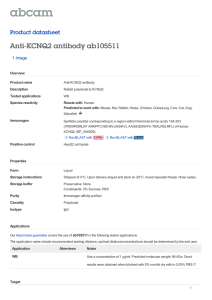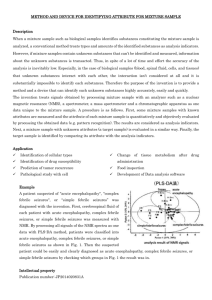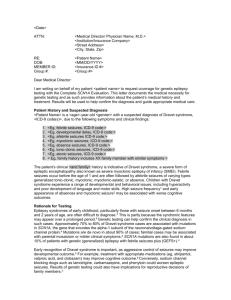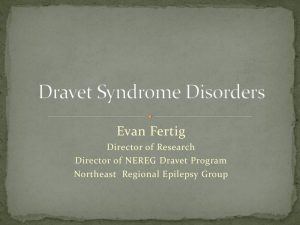Anti-Scn1a antibody ab24820 Product datasheet 6 Abreviews 2 Images
advertisement
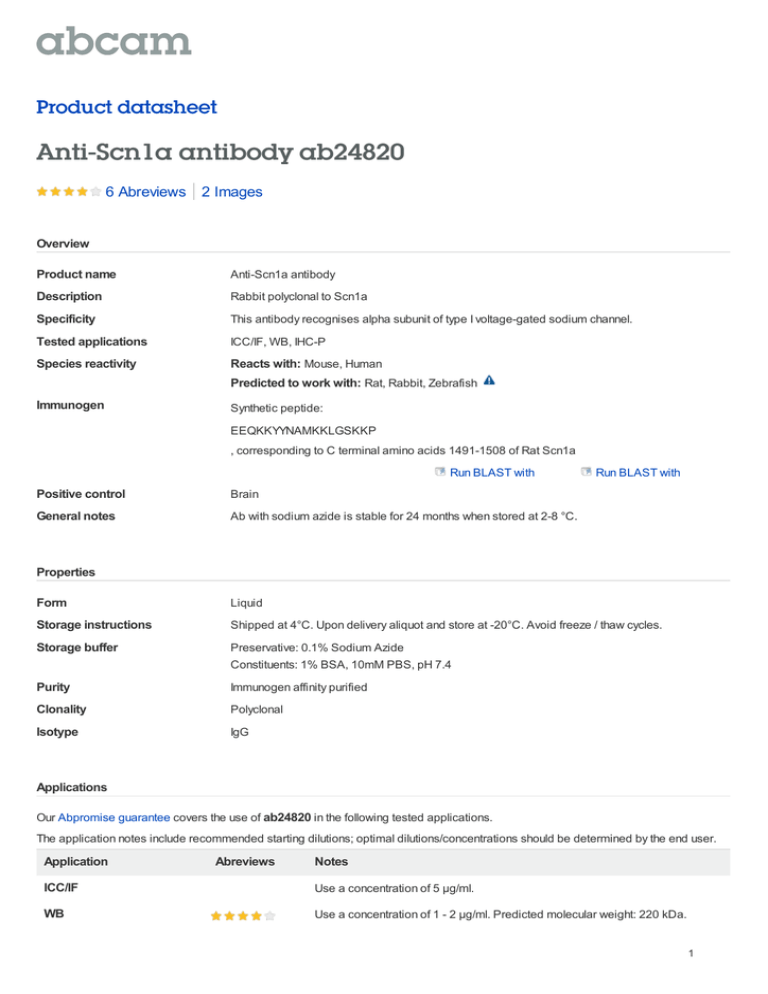
Product datasheet Anti-Scn1a antibody ab24820 6 Abreviews 2 Images Overview Product name Anti-Scn1a antibody Description Rabbit polyclonal to Scn1a Specificity This antibody recognises alpha subunit of type I voltage-gated sodium channel. Tested applications ICC/IF, WB, IHC-P Species reactivity Reacts with: Mouse, Human Predicted to work with: Rat, Rabbit, Zebrafish Immunogen Synthetic peptide: EEQKKYYNAMKKLGSKKP , corresponding to C terminal amino acids 1491-1508 of Rat Scn1a Run BLAST with Positive control Brain General notes Ab with sodium azide is stable for 24 months when stored at 2-8 °C. Run BLAST with Properties Form Liquid Storage instructions Shipped at 4°C. Upon delivery aliquot and store at -20°C. Avoid freeze / thaw cycles. Storage buffer Preservative: 0.1% Sodium Azide Constituents: 1% BSA, 10mM PBS, pH 7.4 Purity Immunogen affinity purified Clonality Polyclonal Isotype IgG Applications Our Abpromise guarantee covers the use of ab24820 in the following tested applications. The application notes include recommended starting dilutions; optimal dilutions/concentrations should be determined by the end user. Application Abreviews Notes ICC/IF Use a concentration of 5 µg/ml. WB Use a concentration of 1 - 2 µg/ml. Predicted molecular weight: 220 kDa. 1 Application Abreviews IHC-P Notes 1/200. Perform heat mediated antigen retrieval with citrate buffer pH 6 before commencing with IHC staining protocol. Application notes Is unsuitable for IHC-FoFr. Target Function Mediates the voltage-dependent sodium ion permeability of excitable membranes. Assuming opened or closed conformations in response to the voltage difference across the membrane, the protein forms a sodium-selective channel through which Na(+) ions may pass in accordance with their electrochemical gradient. Involvement in disease Defects in SCN1A are the cause of generalized epilepsy with febrile seizures plus type 2 (GEFS+2) [MIM:604233]. Generalized epilepsy with febrile seizures-plus refers to a rare autosomal dominant, familial condition with incomplete penetrance and large intrafamilial variability. Patients display febrile seizures persisting sometimes beyond the age of 6 years and/or a variety of afebrile seizure types. GEFS+ is a disease combining febrile seizures, generalized seizures often precipitated by fever at age 6 years or more, and partial seizures, with a variable degree of severity. Defects in SCN1A are a cause of severe myoclonic epilepsy in infancy (SMEI) [MIM:607208]; also called Dravet syndrome. SMEI is a rare disorder characterized by generalized tonic, clonic, and tonic-clonic seizures that are initially induced by fever and begin during the first year of life. Later, patients also manifest other seizure types, including absence, myoclonic, and simple and complex partial seizures. Psychomotor development delay is observed around the second year of life. SMEI is considered to be the most severe phenotype within the spectrum of generalized epilepsies with febrile seizures-plus. Defects in SCN1A are a cause of intractable childhood epilepsy with generalized tonic-clonic seizures (ICEGTC) [MIM:607208]. ICEGTC is a disorder characterized by generalized tonicclonic seizures beginning usually in infancy and induced by fever. Seizures are associated with subsequent mental decline, as well as ataxia or hypotonia. ICEGTC is similar to SMEI, except for the absence of myoclonic seizures. Defects in SCN1A are the cause of migraine familial hemiplegic type 3 (FHM3) [MIM:609634]. FHM3 is an autosomal dominant severe subtype of migraine with aura characterized by some degree of hemiparesis during the attacks. The episodes are associated with variable features of nausea, vomiting, photophobia, and phonophobia. Age at onset ranges from 6 to 15 years. FHM is occasionally associated with other neurologic symptoms such as cerebellar ataxia or epileptic seizures. A unique eye phenotype of elicited repetitive daily blindness has also been reported to be cosegregating with FHM in a single Swiss family. Defects in SCN1A are the cause of familial febrile convulsions type 3A (FEB3A) [MIM:604403]; also known as familial febrile seizures 3. Febrile convulsions are seizures associated with febrile episodes in childhood without any evidence of intracranial infection or defined pathologic or traumatic cause. It is a common condition, affecting 2-5% of children aged 3 months to 5 years. The majority are simple febrile seizures (generally defined as generalized onset, single seizures with a duration of less than 30 minutes). Complex febrile seizures are characterized by focal onset, duration greater than 30 minutes, and/or more than one seizure in a 24 hour period. The likelihood of developing epilepsy following simple febrile seizures is low. Complex febrile seizures are associated with a moderately increased incidence of epilepsy. Sequence similarities Belongs to the sodium channel (TC 1.A.1.10) family. Nav1.1/SCN1A subfamily. Contains 1 IQ domain. Domain The sequence contains 4 internal repeats, each with 5 hydrophobic segments (S1,S2,S3,S5,S6) and one positively charged segment (S4). Segments S4 are probably the voltage-sensors and are characterized by a series of positively charged amino acids at every third position. Cellular localization Membrane. 2 Anti-Scn1a antibody images Staining of human cerebellum with antisodium channel antibody. The tissue was boiled in 10mM citrate buffer, pH 6.0 for 10 mins followed by cooling at room temparture for 20 mins. The working dilution for the Immunohistochemistry (Formalin-fixed paraffin- antibody is 1:200 for 30 min at room embedded sections) - Scn1a antibody (ab24820) temparture. ICC/IF image of ab24820 stained PC12 cells. The cells were 100% methanol fixed (5 min) and then incubated in 1%BSA / 10% normal goat serum / 0.3M glycine in 0.1% PBSTween for 1h to permeabilise the cells and block non-specific protein-protein interactions. The cells were then incubated with the antibody (ab24820, 5µg/ml) overnight at +4°C. The secondary antibody (green) was Alexa Fluor® 488 goat anti-rabbit IgG (H+L) used at a 1/1000 dilution for 1h. Alexa Fluor® Immunocytochemistry/ Immunofluorescence- 594 WGA was used to label plasma Scn1a antibody(ab24820) membranes (red) at a 1/200 dilution for 1h. DAPI was used to stain the cell nuclei (blue) at a concentration of 1.43µM. Please note: All products are "FOR RESEARCH USE ONLY AND ARE NOT INTENDED FOR DIAGNOSTIC OR THERAPEUTIC USE" Our Abpromise to you: Quality guaranteed and expert technical support Replacement or refund for products not performing as stated on the datasheet Valid for 12 months from date of delivery Response to your inquiry within 24 hours We provide support in Chinese, English, French, German, Japanese and Spanish Extensive multi-media technical resources to help you We investigate all quality concerns to ensure our products perform to the highest standards If the product does not perform as described on this datasheet, we will offer a refund or replacement. For full details of the Abpromise, please visit http://www.abcam.com/abpromise or contact our technical team. Terms and conditions Guarantee only valid for products bought direct from Abcam or one of our authorized distributors 3
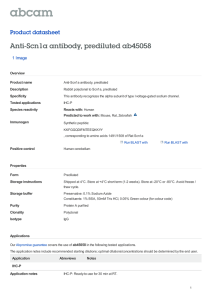
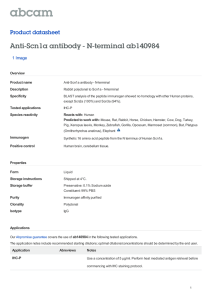
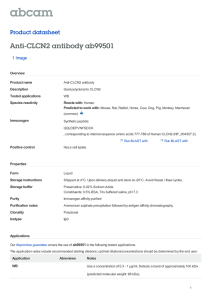

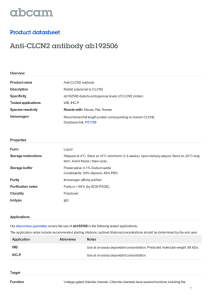
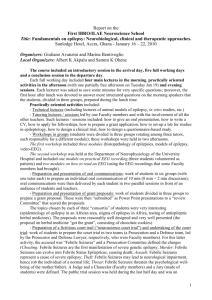
![Anti-Nav1.7 antibody [S68-6] - C-terminal (Biotin) ab183416](http://s2.studylib.net/store/data/012700010_1-91302de8adf12cece525fff12806561f-300x300.png)
![Anti-Nav1.7 antibody [S68-6] - C-terminal (HRP) ab183415](http://s2.studylib.net/store/data/012700012_1-f61981161b0130b1425b18a53b545f85-300x300.png)
